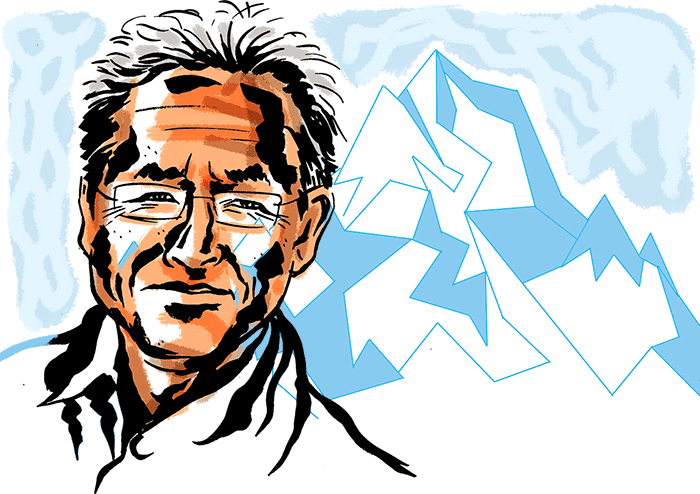 | « Back to article | Print this article |
Anshul meets Sonam Wangchuk, the man who inspired Aamir Khan's role in 3 Idiots.
Illustration: Dominic Xavier/Rediff.com

Do the names Phunsukh Wangdu or Rancchoddas Shyamaldas Chanchad aka Rancho ring a bell?
They are the various names of the protagonist in Raju Hirani's movie, 3 Idiots, played by Aamir Khan.
The character they belonged to wasn't a figment of a fertile imagination, but drew inspiration from the real life story of an engineer-cum-scientist called Sonam Wangchuk.
This Ladakh-based genius has been building 'ice stupas' fashioned as artificial glaciers to address the chronic water problem in the community he lives in.
While Wangchuk's initiatives were first noticed and brought into prominence by 3 Idiots in 2009, there's more to this engineer-turned-educationist than what was shown on celluloid.
Wangchuk is the founding director of the Students Educational and Cultural Movement of Ladakh that was established in 1988 by a group of students.
The institute's campus, which he designed, runs on solar energy and uses no fossil fuel for cooking, lighting or heating.
He has also come up with a novel way of providing fresh water to villages in the upper reaches of Ladakh that are home to one of the highest deserts in the world.
He sources water from nearby streams and uses it to create artificial glaciers that stock fresh water that comes very handy in springtime.
The Ladakh region, at an altitude of about 3,500 metres between the Kunlun and the Great Himalayan mountain ranges, faces chronic water shortage during the April-May early crop-growing period.
Wangchuk was certain that access to water in the desert landscape of many high altitude towns and villages in this Himalayan region could be enhanced if the massive seasonal outflow of glacial water could be frozen and stored.
Inspired by the experimental work of Chewang Norphel, a fellow Ladakhi engineer, Wangchuk developed a simple and effective system, creating what he calls 'ice stupas' -- conical mounds that double up as mini glaciers, slowly releasing water during the cropping season.
The 'ice stupas' glaciers are built during winter and naturally melt during spring to water the barren desert fields.
Says Wangchuk, "There have been others before who have worked in this field but encountered problems such as premature melting. To address these problems, we have built vertical ice towers using a simple method."
A pipe brings water from the upstream to the downstream.
"When you do that, the build-up of pressure in the pipe is used to run a fountain that sprays water in the air," he explains.
"When the water is sprayed in the minus 20 degrees Celsius temperatures of the Ladakhi winter, it freezes as it falls and takes the shape of a giant conical structure."
The conical tower shape ensures that the surface exposed to the sun is minimal, so premature melting is avoided.
Wangchuk, who received the Rolex Award for Enterprise in November 2016 for his innovative work, is using the prize money to fund the Ice Stupa Project, consisting of up to 20 such 'ice stupas' each 30 metres high and capable of supplying millions of litres of water.
Another long-term goal, related to the project, is to build an alternative university and engage the youth in the environment.
This project started some years ago.
Today, the desert landscape has turned green and the level of groundwater in the area has risen substantially.
"I'm not doing anything revolutionary. It is Class 9 science put to use. We mountain people have to find new ways to work with nature, not against it," he says modestly.
The breakthrough moment, so to speak, came in the winter of 2013 when Wangchuk and his students succeeded in freezing 150,000 litres of water into a six-feet 'ice stupa' at an altitude of about 3,000 metres.
This experimental giant 'ice stupa' survived the ensuing warm, dry spring season and lasted until May.
If this could be achieved once, it could be achieved again.
There was no stopping Wangchuk from creating more such gigantic 'ice stupas' -- they are named so because they resemble Buddhist stupas -- anywhere in the icy Ladakhi desert.
In the winter of 2014 that followed, Wangchuk and his team built an even larger ice stupa.
This one survived most of June and, during its lifespan, released two million litres of water.
The success of the first stupa had helped bring in Rs 75 lakh (Rs 7.5 million) in donations that were pumped into building the second stupa.
The maximum cost of the project goes into laying the pipe that brings water from the streams to the place where the stupa is set up.
Once this pipe is in place, it does not cost much to build the stupas winter after winter.
Wangchuk was born and raised in a tiny village of five households some 70 km from Leh and spent the first nine years of his life acquiring a holistic and symphonic education.
Since 1994, he has been running a solar-powered school -- built by the students, for the students and run by the students whom the education system has rejected as failures.
He has also worked with the Jammu and Kashmir government to get textbooks for government schools in Ladakh changed to make them accessible to students in their language.